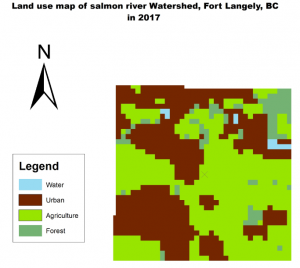Groundwater recharge is directly influenced by Land use and land use changes. Urbanization for example interrupts the natural hydrologic cycles by decreasing infiltration and increasing runoff, as a result to an increase in impervious surfaces.
Groundwater recharge is also effected by the increase of agricultural farms, worth mentioning that the only land cover that maintains a natural path of water through the soil are forests. Moreover, levels of ground water are highly influenced by these factors. Urbanization, population growth and increase in agricultural production add increasing pressures on groundwater resources. Thus, understanding changes in land is a necessity in urban planning and sustainable resource management.

Three band image year 2017

Three band image year 2007
The figures above were extracted from landsat for subsequent classification of land use. The three band colors used in these imageries are blue, green and red representing urban, forest and agriculture and water bodies. Figure 5 and 6 shows the same zones after a supervised classification using ArcMap.
The land use figures below represents land use in years 2017 and 2007 respectively. As described in the legend, the landsat images were classified into four classifications, namely, water, urban developments, forest and agriculture. By comparing the two years together, we can observe a clear change in land use, both urban and agricultural lands have increased on the expense of forests.
The increase in urban and agricultural developments in Langley watershed will have adverse impacts on the Hopington aquifer. First, the increase in the brown color means more impervious surfaces and more runoff decreasing the amount of water naturally infiltrating to groundwater. Moreover vegetation and soil quality is agricultural settings plays a less but similar role to urban environments and adds to the interruptions to the natural paths of water flows, impacting the recharge potential of groundwater in the area.
Impacts on groundwater due to a changing land use in the langley watershed is not restricted to ground water recharge potential but extends to the depletion of groundwater quantity and quality due to an increase in groundwater abstraction for an increasing need. Quality deterioration is also expected due to leaching of a number of environmental hazards into groundwater, that could include heavy metals, oil and grease as well others from agricultural settings such as nitrate and phosphorus.


